Augmented Reality in Education: Applications, Benefits and Drawbacks
VerifiedAdded on 2023/04/24
|19
|3907
|351
AI Summary
This report discusses the topic of Augmented Reality in education, including recent developments, applications in industries, and its implementation in the education sector. It also covers the benefits and drawbacks of using AR in education, hardware requirements for implementation, and recommendations for the client company. The report suggests three disciplines where AR could have a significant impact and provides examples of how AR can be used in astronomy, chemistry, and biology.
Contribute Materials
Your contribution can guide someone’s learning journey. Share your
documents today.
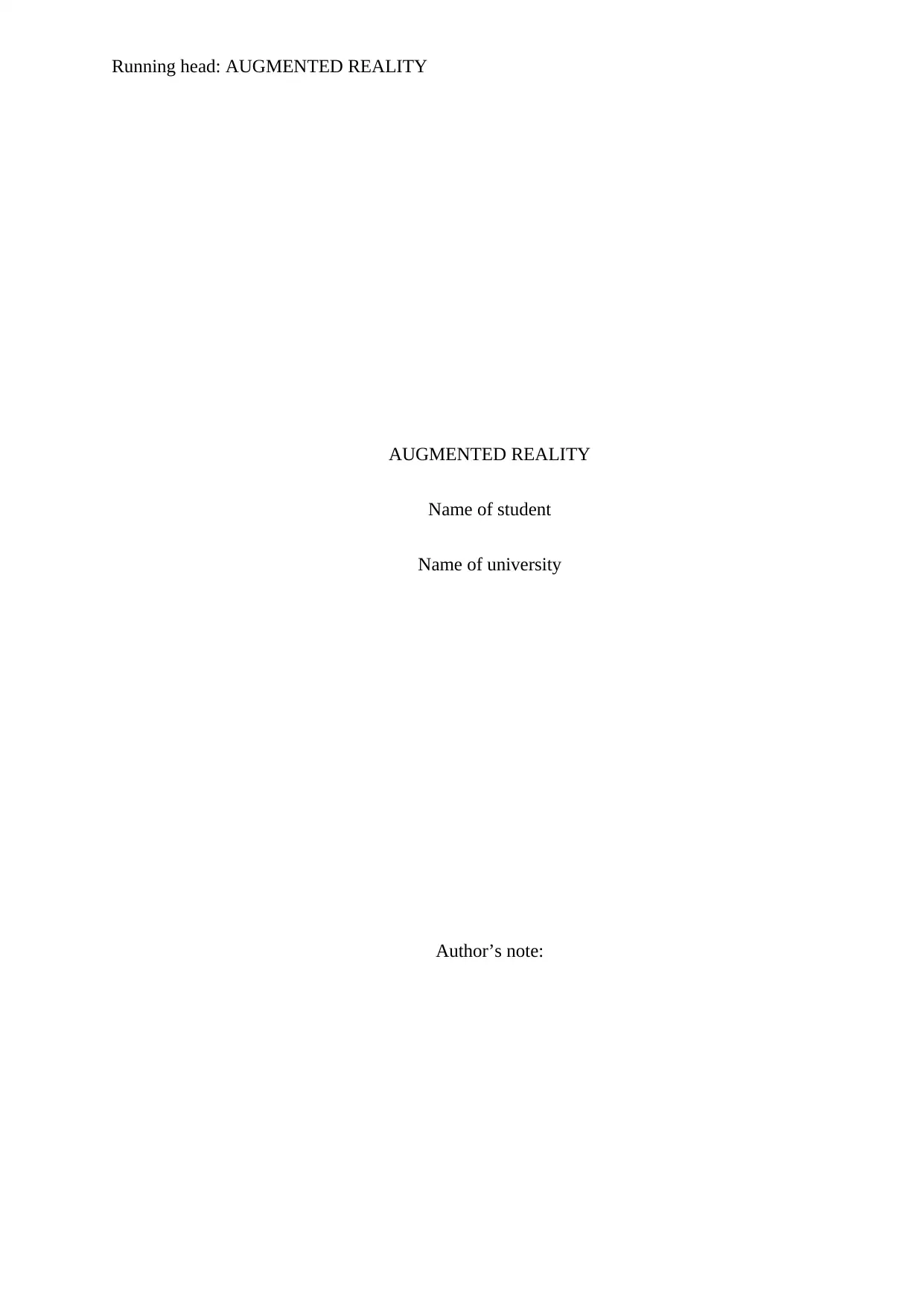
Running head: AUGMENTED REALITY
AUGMENTED REALITY
Name of student
Name of university
Author’s note:
AUGMENTED REALITY
Name of student
Name of university
Author’s note:
Secure Best Marks with AI Grader
Need help grading? Try our AI Grader for instant feedback on your assignments.
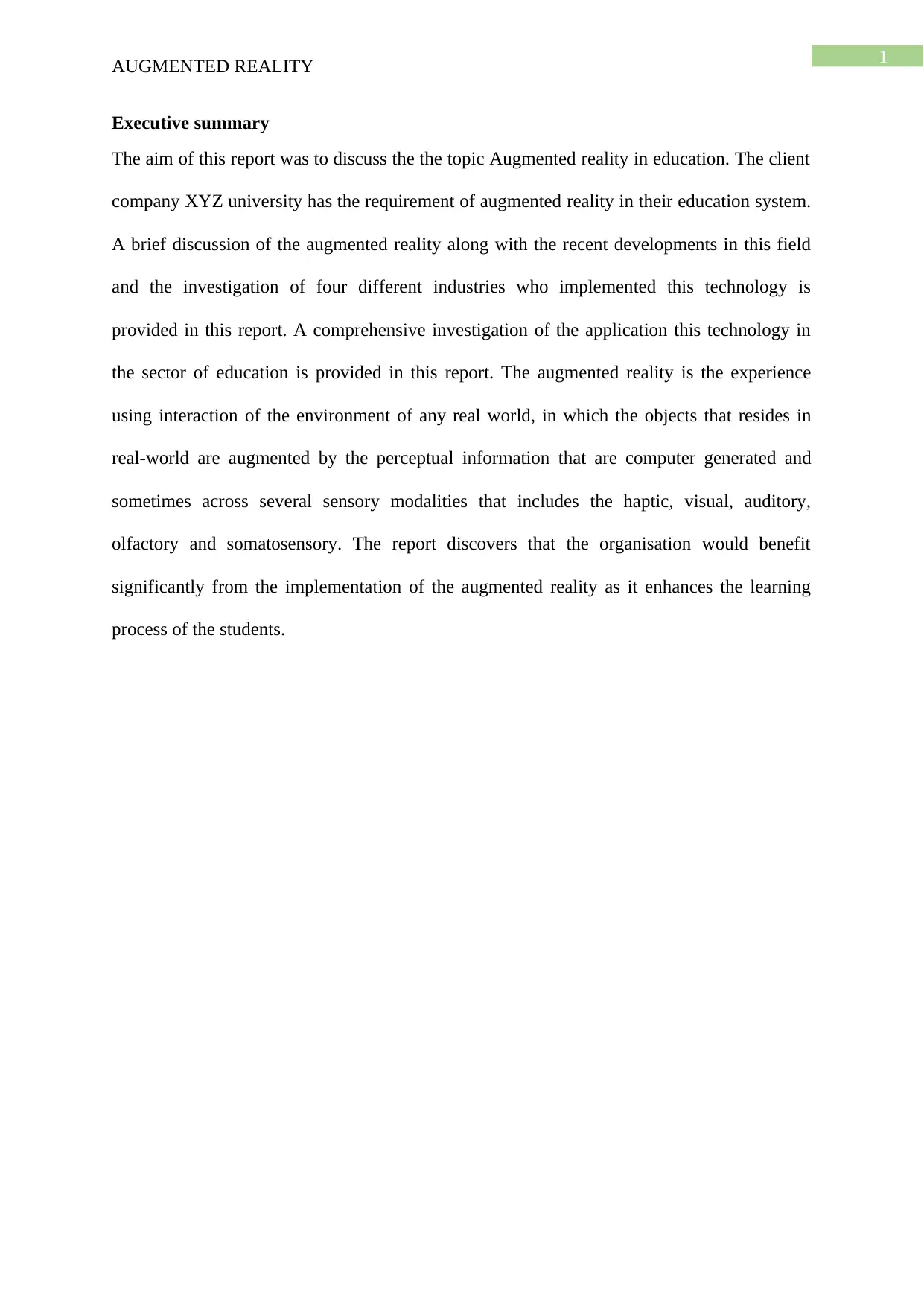
1
AUGMENTED REALITY
Executive summary
The aim of this report was to discuss the the topic Augmented reality in education. The client
company XYZ university has the requirement of augmented reality in their education system.
A brief discussion of the augmented reality along with the recent developments in this field
and the investigation of four different industries who implemented this technology is
provided in this report. A comprehensive investigation of the application this technology in
the sector of education is provided in this report. The augmented reality is the experience
using interaction of the environment of any real world, in which the objects that resides in
real-world are augmented by the perceptual information that are computer generated and
sometimes across several sensory modalities that includes the haptic, visual, auditory,
olfactory and somatosensory. The report discovers that the organisation would benefit
significantly from the implementation of the augmented reality as it enhances the learning
process of the students.
AUGMENTED REALITY
Executive summary
The aim of this report was to discuss the the topic Augmented reality in education. The client
company XYZ university has the requirement of augmented reality in their education system.
A brief discussion of the augmented reality along with the recent developments in this field
and the investigation of four different industries who implemented this technology is
provided in this report. A comprehensive investigation of the application this technology in
the sector of education is provided in this report. The augmented reality is the experience
using interaction of the environment of any real world, in which the objects that resides in
real-world are augmented by the perceptual information that are computer generated and
sometimes across several sensory modalities that includes the haptic, visual, auditory,
olfactory and somatosensory. The report discovers that the organisation would benefit
significantly from the implementation of the augmented reality as it enhances the learning
process of the students.
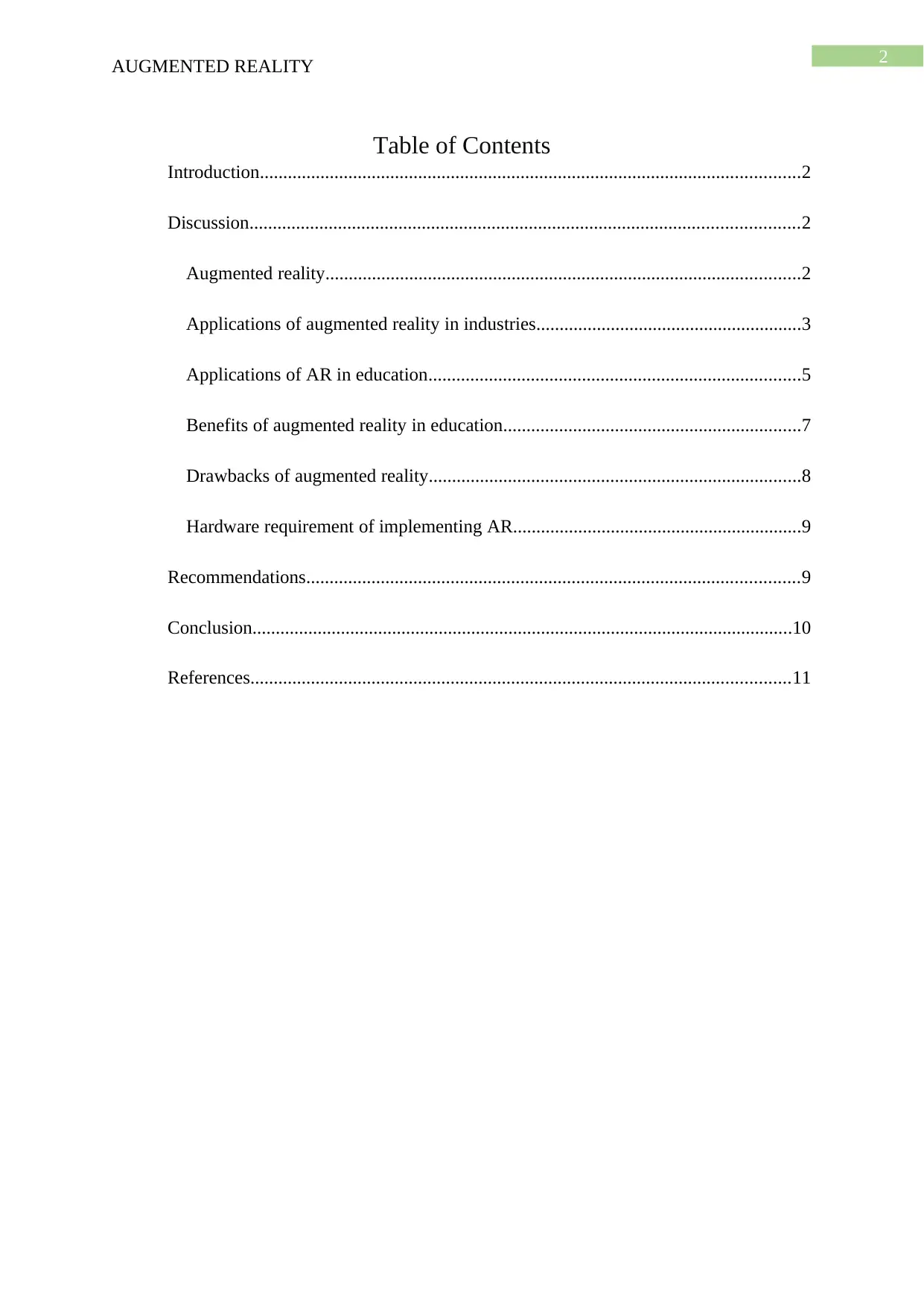
2
AUGMENTED REALITY
Table of Contents
Introduction....................................................................................................................2
Discussion......................................................................................................................2
Augmented reality......................................................................................................2
Applications of augmented reality in industries.........................................................3
Applications of AR in education................................................................................5
Benefits of augmented reality in education................................................................7
Drawbacks of augmented reality................................................................................8
Hardware requirement of implementing AR..............................................................9
Recommendations..........................................................................................................9
Conclusion....................................................................................................................10
References....................................................................................................................11
AUGMENTED REALITY
Table of Contents
Introduction....................................................................................................................2
Discussion......................................................................................................................2
Augmented reality......................................................................................................2
Applications of augmented reality in industries.........................................................3
Applications of AR in education................................................................................5
Benefits of augmented reality in education................................................................7
Drawbacks of augmented reality................................................................................8
Hardware requirement of implementing AR..............................................................9
Recommendations..........................................................................................................9
Conclusion....................................................................................................................10
References....................................................................................................................11
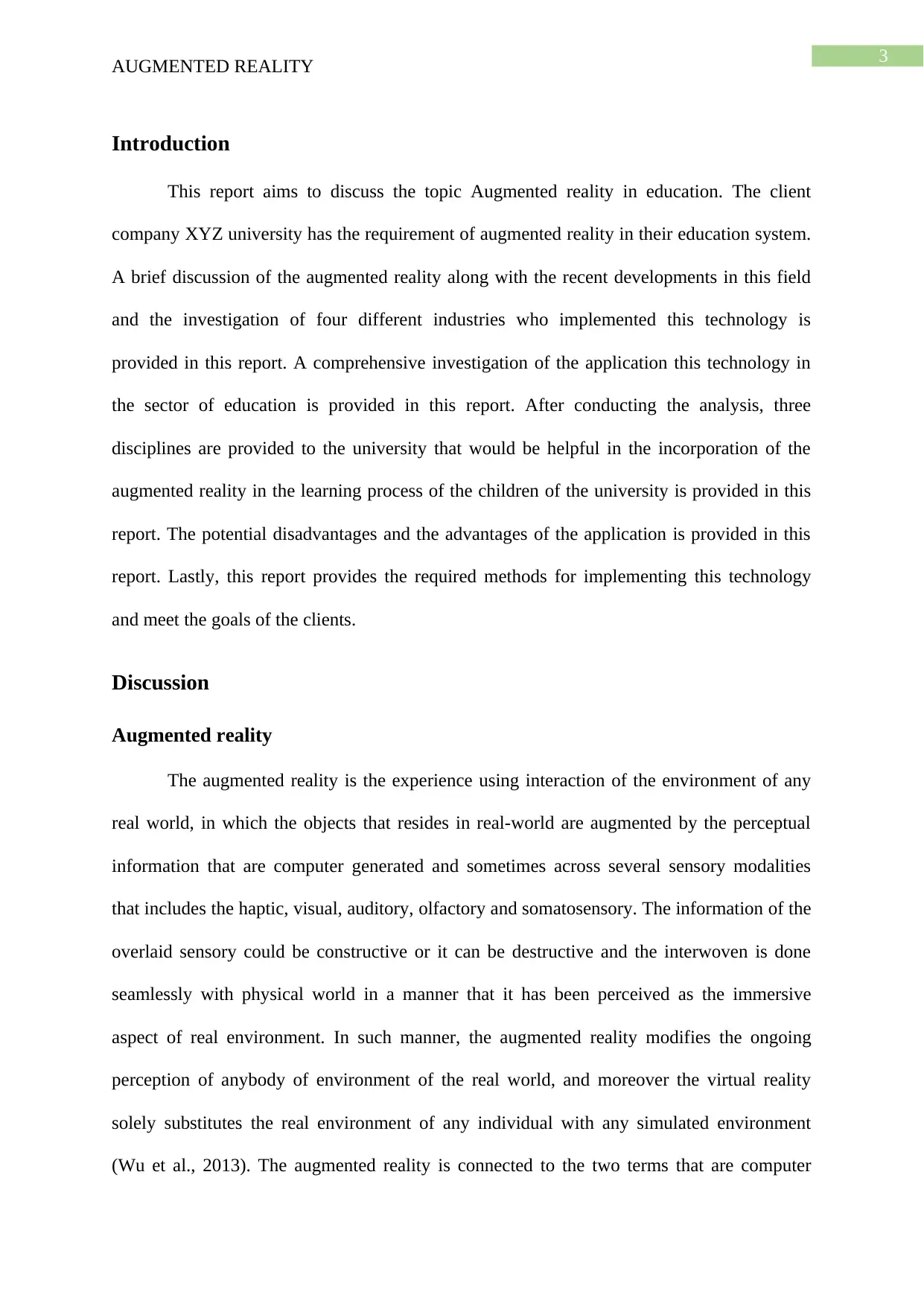
3
AUGMENTED REALITY
Introduction
This report aims to discuss the topic Augmented reality in education. The client
company XYZ university has the requirement of augmented reality in their education system.
A brief discussion of the augmented reality along with the recent developments in this field
and the investigation of four different industries who implemented this technology is
provided in this report. A comprehensive investigation of the application this technology in
the sector of education is provided in this report. After conducting the analysis, three
disciplines are provided to the university that would be helpful in the incorporation of the
augmented reality in the learning process of the children of the university is provided in this
report. The potential disadvantages and the advantages of the application is provided in this
report. Lastly, this report provides the required methods for implementing this technology
and meet the goals of the clients.
Discussion
Augmented reality
The augmented reality is the experience using interaction of the environment of any
real world, in which the objects that resides in real-world are augmented by the perceptual
information that are computer generated and sometimes across several sensory modalities
that includes the haptic, visual, auditory, olfactory and somatosensory. The information of the
overlaid sensory could be constructive or it can be destructive and the interwoven is done
seamlessly with physical world in a manner that it has been perceived as the immersive
aspect of real environment. In such manner, the augmented reality modifies the ongoing
perception of anybody of environment of the real world, and moreover the virtual reality
solely substitutes the real environment of any individual with any simulated environment
(Wu et al., 2013). The augmented reality is connected to the two terms that are computer
AUGMENTED REALITY
Introduction
This report aims to discuss the topic Augmented reality in education. The client
company XYZ university has the requirement of augmented reality in their education system.
A brief discussion of the augmented reality along with the recent developments in this field
and the investigation of four different industries who implemented this technology is
provided in this report. A comprehensive investigation of the application this technology in
the sector of education is provided in this report. After conducting the analysis, three
disciplines are provided to the university that would be helpful in the incorporation of the
augmented reality in the learning process of the children of the university is provided in this
report. The potential disadvantages and the advantages of the application is provided in this
report. Lastly, this report provides the required methods for implementing this technology
and meet the goals of the clients.
Discussion
Augmented reality
The augmented reality is the experience using interaction of the environment of any
real world, in which the objects that resides in real-world are augmented by the perceptual
information that are computer generated and sometimes across several sensory modalities
that includes the haptic, visual, auditory, olfactory and somatosensory. The information of the
overlaid sensory could be constructive or it can be destructive and the interwoven is done
seamlessly with physical world in a manner that it has been perceived as the immersive
aspect of real environment. In such manner, the augmented reality modifies the ongoing
perception of anybody of environment of the real world, and moreover the virtual reality
solely substitutes the real environment of any individual with any simulated environment
(Wu et al., 2013). The augmented reality is connected to the two terms that are computer
Secure Best Marks with AI Grader
Need help grading? Try our AI Grader for instant feedback on your assignments.
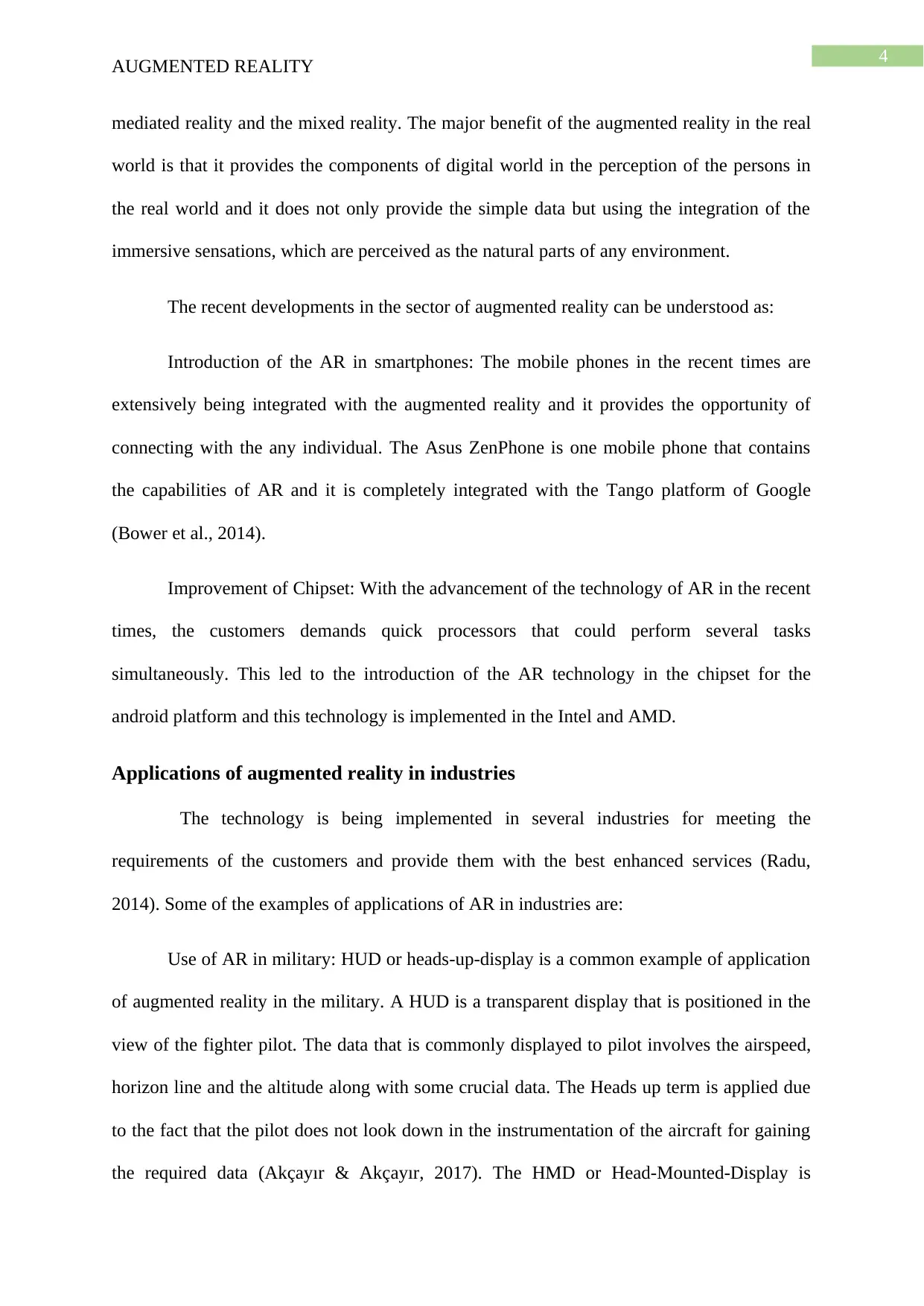
4
AUGMENTED REALITY
mediated reality and the mixed reality. The major benefit of the augmented reality in the real
world is that it provides the components of digital world in the perception of the persons in
the real world and it does not only provide the simple data but using the integration of the
immersive sensations, which are perceived as the natural parts of any environment.
The recent developments in the sector of augmented reality can be understood as:
Introduction of the AR in smartphones: The mobile phones in the recent times are
extensively being integrated with the augmented reality and it provides the opportunity of
connecting with the any individual. The Asus ZenPhone is one mobile phone that contains
the capabilities of AR and it is completely integrated with the Tango platform of Google
(Bower et al., 2014).
Improvement of Chipset: With the advancement of the technology of AR in the recent
times, the customers demands quick processors that could perform several tasks
simultaneously. This led to the introduction of the AR technology in the chipset for the
android platform and this technology is implemented in the Intel and AMD.
Applications of augmented reality in industries
The technology is being implemented in several industries for meeting the
requirements of the customers and provide them with the best enhanced services (Radu,
2014). Some of the examples of applications of AR in industries are:
Use of AR in military: HUD or heads-up-display is a common example of application
of augmented reality in the military. A HUD is a transparent display that is positioned in the
view of the fighter pilot. The data that is commonly displayed to pilot involves the airspeed,
horizon line and the altitude along with some crucial data. The Heads up term is applied due
to the fact that the pilot does not look down in the instrumentation of the aircraft for gaining
the required data (Akçayır & Akçayır, 2017). The HMD or Head-Mounted-Display is
AUGMENTED REALITY
mediated reality and the mixed reality. The major benefit of the augmented reality in the real
world is that it provides the components of digital world in the perception of the persons in
the real world and it does not only provide the simple data but using the integration of the
immersive sensations, which are perceived as the natural parts of any environment.
The recent developments in the sector of augmented reality can be understood as:
Introduction of the AR in smartphones: The mobile phones in the recent times are
extensively being integrated with the augmented reality and it provides the opportunity of
connecting with the any individual. The Asus ZenPhone is one mobile phone that contains
the capabilities of AR and it is completely integrated with the Tango platform of Google
(Bower et al., 2014).
Improvement of Chipset: With the advancement of the technology of AR in the recent
times, the customers demands quick processors that could perform several tasks
simultaneously. This led to the introduction of the AR technology in the chipset for the
android platform and this technology is implemented in the Intel and AMD.
Applications of augmented reality in industries
The technology is being implemented in several industries for meeting the
requirements of the customers and provide them with the best enhanced services (Radu,
2014). Some of the examples of applications of AR in industries are:
Use of AR in military: HUD or heads-up-display is a common example of application
of augmented reality in the military. A HUD is a transparent display that is positioned in the
view of the fighter pilot. The data that is commonly displayed to pilot involves the airspeed,
horizon line and the altitude along with some crucial data. The Heads up term is applied due
to the fact that the pilot does not look down in the instrumentation of the aircraft for gaining
the required data (Akçayır & Akçayır, 2017). The HMD or Head-Mounted-Display is
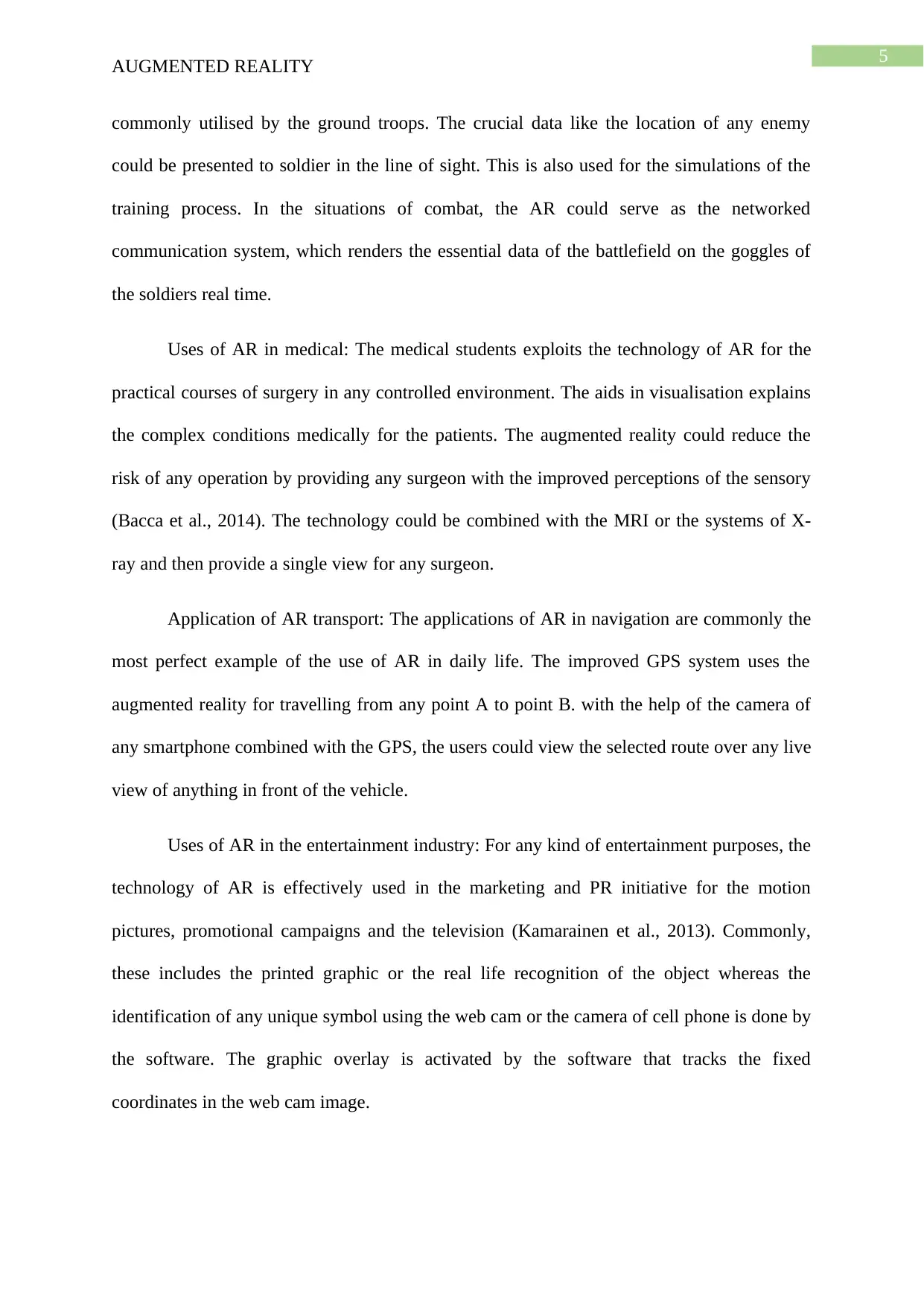
5
AUGMENTED REALITY
commonly utilised by the ground troops. The crucial data like the location of any enemy
could be presented to soldier in the line of sight. This is also used for the simulations of the
training process. In the situations of combat, the AR could serve as the networked
communication system, which renders the essential data of the battlefield on the goggles of
the soldiers real time.
Uses of AR in medical: The medical students exploits the technology of AR for the
practical courses of surgery in any controlled environment. The aids in visualisation explains
the complex conditions medically for the patients. The augmented reality could reduce the
risk of any operation by providing any surgeon with the improved perceptions of the sensory
(Bacca et al., 2014). The technology could be combined with the MRI or the systems of X-
ray and then provide a single view for any surgeon.
Application of AR transport: The applications of AR in navigation are commonly the
most perfect example of the use of AR in daily life. The improved GPS system uses the
augmented reality for travelling from any point A to point B. with the help of the camera of
any smartphone combined with the GPS, the users could view the selected route over any live
view of anything in front of the vehicle.
Uses of AR in the entertainment industry: For any kind of entertainment purposes, the
technology of AR is effectively used in the marketing and PR initiative for the motion
pictures, promotional campaigns and the television (Kamarainen et al., 2013). Commonly,
these includes the printed graphic or the real life recognition of the object whereas the
identification of any unique symbol using the web cam or the camera of cell phone is done by
the software. The graphic overlay is activated by the software that tracks the fixed
coordinates in the web cam image.
AUGMENTED REALITY
commonly utilised by the ground troops. The crucial data like the location of any enemy
could be presented to soldier in the line of sight. This is also used for the simulations of the
training process. In the situations of combat, the AR could serve as the networked
communication system, which renders the essential data of the battlefield on the goggles of
the soldiers real time.
Uses of AR in medical: The medical students exploits the technology of AR for the
practical courses of surgery in any controlled environment. The aids in visualisation explains
the complex conditions medically for the patients. The augmented reality could reduce the
risk of any operation by providing any surgeon with the improved perceptions of the sensory
(Bacca et al., 2014). The technology could be combined with the MRI or the systems of X-
ray and then provide a single view for any surgeon.
Application of AR transport: The applications of AR in navigation are commonly the
most perfect example of the use of AR in daily life. The improved GPS system uses the
augmented reality for travelling from any point A to point B. with the help of the camera of
any smartphone combined with the GPS, the users could view the selected route over any live
view of anything in front of the vehicle.
Uses of AR in the entertainment industry: For any kind of entertainment purposes, the
technology of AR is effectively used in the marketing and PR initiative for the motion
pictures, promotional campaigns and the television (Kamarainen et al., 2013). Commonly,
these includes the printed graphic or the real life recognition of the object whereas the
identification of any unique symbol using the web cam or the camera of cell phone is done by
the software. The graphic overlay is activated by the software that tracks the fixed
coordinates in the web cam image.

6
AUGMENTED REALITY
Applications of AR in education
The implementation of the AR in the education allows significant flexibility in the
education sector. The technology of AR could be utilised using various mediums that
includes the desktops, smartphones and the mobile devices. The feature of this technology of
being adaptable and portable makes it easier to use and efficiently utilise. The AR could be
used for enhancing the instruction and content in any conventional classroom, supplement the
instruction in the educational classroom, extend the content in the world outside any
classroom along with combining with several other technologies for enriching the individual
applications (Chen et al., 2017).
Uses in special education
As the technology of AR consists of the ability of bridging the physical and learning
behaviour, it consists of huge potential of bringing the value and the enhanced quality of
experiences of education to the students with the physical and learning disabilities and the
special classroom for education. It has been observed by several researchers that the use of
the augmented storybooks leads to the increase in the positive results as the students are able
to remember the stories and they have significant comprehension of reading (Kamphuis et al.,
2014). The augmented storybooks could specifically help the students who have a lack in
comprehending the materials that based on the text. The physical movement is commonly the
consideration and the component for the tasks of AR. Any student might struggle in engaging
under any normal circumstances but they can easily get involved in kinaesthetic nature that is
implemented by the augmented tasks. The conventional classrooms also deploys the
functions of AR for enhancing the learning experiences of the students (Martín-Gutiérrez et
al., 2015). It has been discovered that due to the restraints in the budget or time, often the
educational centres hesitate to implement the technology. The desktop AR offers the students
with the ability of combining the images that are both computer generated and real. Several
AUGMENTED REALITY
Applications of AR in education
The implementation of the AR in the education allows significant flexibility in the
education sector. The technology of AR could be utilised using various mediums that
includes the desktops, smartphones and the mobile devices. The feature of this technology of
being adaptable and portable makes it easier to use and efficiently utilise. The AR could be
used for enhancing the instruction and content in any conventional classroom, supplement the
instruction in the educational classroom, extend the content in the world outside any
classroom along with combining with several other technologies for enriching the individual
applications (Chen et al., 2017).
Uses in special education
As the technology of AR consists of the ability of bridging the physical and learning
behaviour, it consists of huge potential of bringing the value and the enhanced quality of
experiences of education to the students with the physical and learning disabilities and the
special classroom for education. It has been observed by several researchers that the use of
the augmented storybooks leads to the increase in the positive results as the students are able
to remember the stories and they have significant comprehension of reading (Kamphuis et al.,
2014). The augmented storybooks could specifically help the students who have a lack in
comprehending the materials that based on the text. The physical movement is commonly the
consideration and the component for the tasks of AR. Any student might struggle in engaging
under any normal circumstances but they can easily get involved in kinaesthetic nature that is
implemented by the augmented tasks. The conventional classrooms also deploys the
functions of AR for enhancing the learning experiences of the students (Martín-Gutiérrez et
al., 2015). It has been discovered that due to the restraints in the budget or time, often the
educational centres hesitate to implement the technology. The desktop AR offers the students
with the ability of combining the images that are both computer generated and real. Several
Paraphrase This Document
Need a fresh take? Get an instant paraphrase of this document with our AI Paraphraser
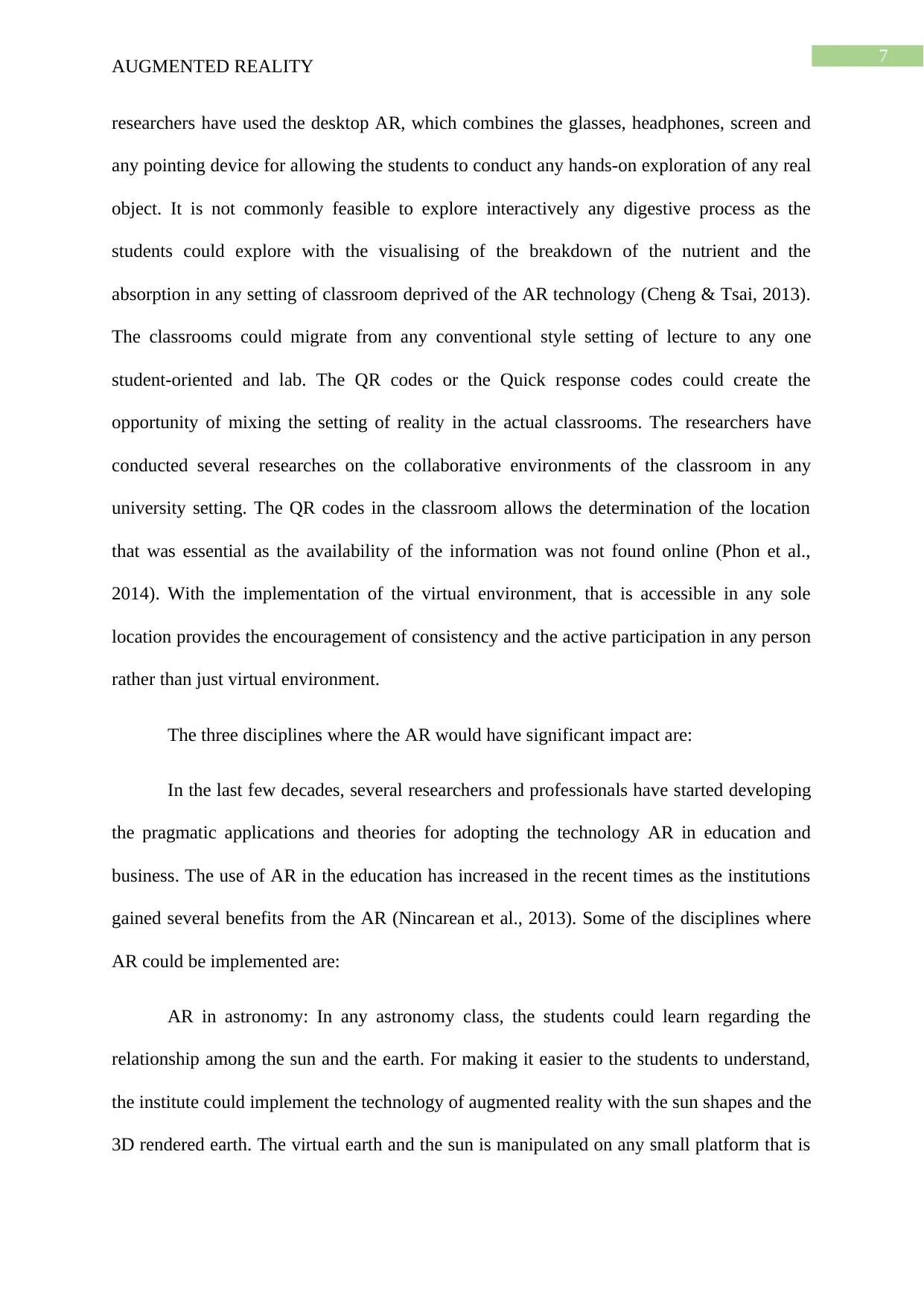
7
AUGMENTED REALITY
researchers have used the desktop AR, which combines the glasses, headphones, screen and
any pointing device for allowing the students to conduct any hands-on exploration of any real
object. It is not commonly feasible to explore interactively any digestive process as the
students could explore with the visualising of the breakdown of the nutrient and the
absorption in any setting of classroom deprived of the AR technology (Cheng & Tsai, 2013).
The classrooms could migrate from any conventional style setting of lecture to any one
student-oriented and lab. The QR codes or the Quick response codes could create the
opportunity of mixing the setting of reality in the actual classrooms. The researchers have
conducted several researches on the collaborative environments of the classroom in any
university setting. The QR codes in the classroom allows the determination of the location
that was essential as the availability of the information was not found online (Phon et al.,
2014). With the implementation of the virtual environment, that is accessible in any sole
location provides the encouragement of consistency and the active participation in any person
rather than just virtual environment.
The three disciplines where the AR would have significant impact are:
In the last few decades, several researchers and professionals have started developing
the pragmatic applications and theories for adopting the technology AR in education and
business. The use of AR in the education has increased in the recent times as the institutions
gained several benefits from the AR (Nincarean et al., 2013). Some of the disciplines where
AR could be implemented are:
AR in astronomy: In any astronomy class, the students could learn regarding the
relationship among the sun and the earth. For making it easier to the students to understand,
the institute could implement the technology of augmented reality with the sun shapes and the
3D rendered earth. The virtual earth and the sun is manipulated on any small platform that is
AUGMENTED REALITY
researchers have used the desktop AR, which combines the glasses, headphones, screen and
any pointing device for allowing the students to conduct any hands-on exploration of any real
object. It is not commonly feasible to explore interactively any digestive process as the
students could explore with the visualising of the breakdown of the nutrient and the
absorption in any setting of classroom deprived of the AR technology (Cheng & Tsai, 2013).
The classrooms could migrate from any conventional style setting of lecture to any one
student-oriented and lab. The QR codes or the Quick response codes could create the
opportunity of mixing the setting of reality in the actual classrooms. The researchers have
conducted several researches on the collaborative environments of the classroom in any
university setting. The QR codes in the classroom allows the determination of the location
that was essential as the availability of the information was not found online (Phon et al.,
2014). With the implementation of the virtual environment, that is accessible in any sole
location provides the encouragement of consistency and the active participation in any person
rather than just virtual environment.
The three disciplines where the AR would have significant impact are:
In the last few decades, several researchers and professionals have started developing
the pragmatic applications and theories for adopting the technology AR in education and
business. The use of AR in the education has increased in the recent times as the institutions
gained several benefits from the AR (Nincarean et al., 2013). Some of the disciplines where
AR could be implemented are:
AR in astronomy: In any astronomy class, the students could learn regarding the
relationship among the sun and the earth. For making it easier to the students to understand,
the institute could implement the technology of augmented reality with the sun shapes and the
3D rendered earth. The virtual earth and the sun is manipulated on any small platform that is
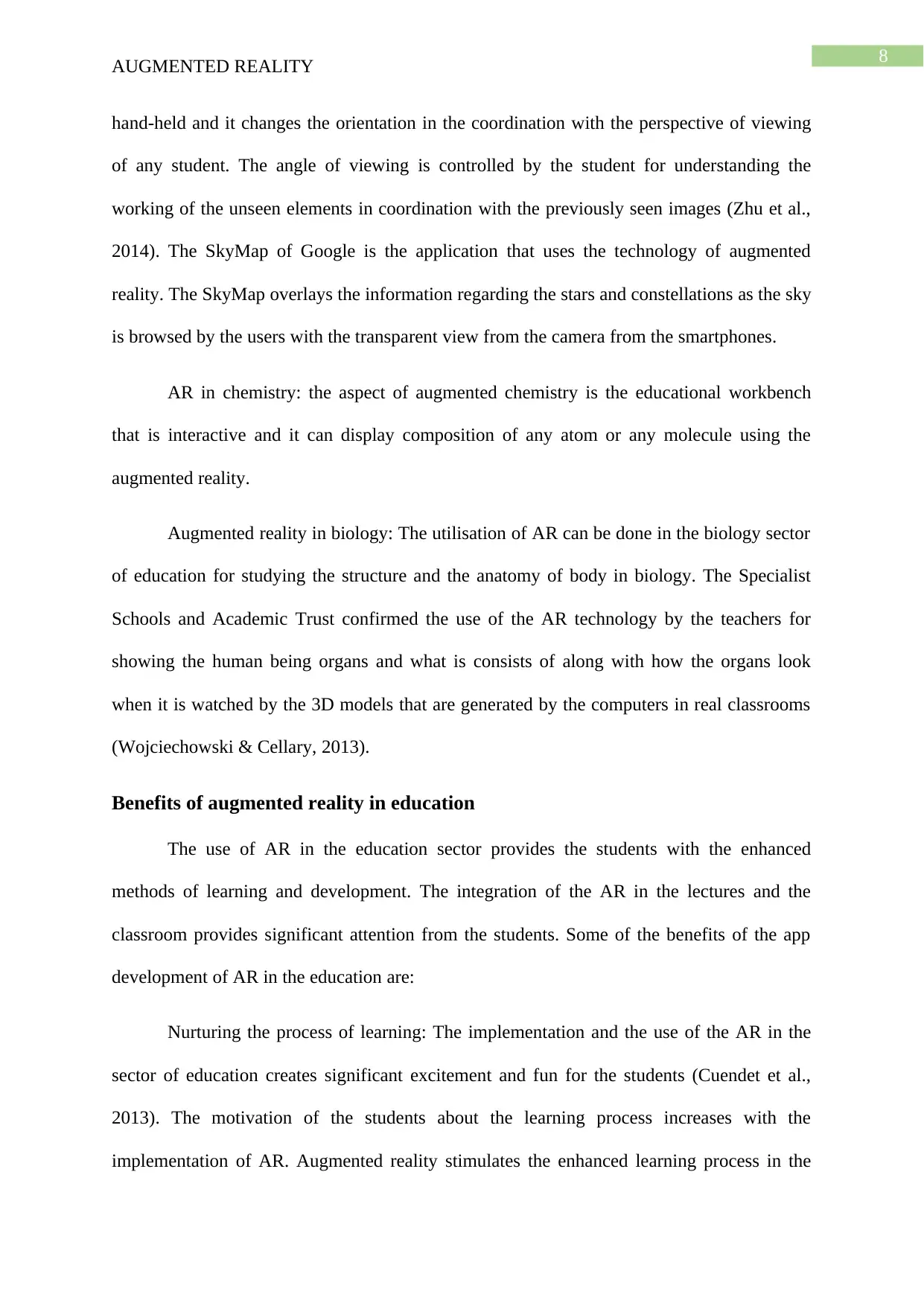
8
AUGMENTED REALITY
hand-held and it changes the orientation in the coordination with the perspective of viewing
of any student. The angle of viewing is controlled by the student for understanding the
working of the unseen elements in coordination with the previously seen images (Zhu et al.,
2014). The SkyMap of Google is the application that uses the technology of augmented
reality. The SkyMap overlays the information regarding the stars and constellations as the sky
is browsed by the users with the transparent view from the camera from the smartphones.
AR in chemistry: the aspect of augmented chemistry is the educational workbench
that is interactive and it can display composition of any atom or any molecule using the
augmented reality.
Augmented reality in biology: The utilisation of AR can be done in the biology sector
of education for studying the structure and the anatomy of body in biology. The Specialist
Schools and Academic Trust confirmed the use of the AR technology by the teachers for
showing the human being organs and what is consists of along with how the organs look
when it is watched by the 3D models that are generated by the computers in real classrooms
(Wojciechowski & Cellary, 2013).
Benefits of augmented reality in education
The use of AR in the education sector provides the students with the enhanced
methods of learning and development. The integration of the AR in the lectures and the
classroom provides significant attention from the students. Some of the benefits of the app
development of AR in the education are:
Nurturing the process of learning: The implementation and the use of the AR in the
sector of education creates significant excitement and fun for the students (Cuendet et al.,
2013). The motivation of the students about the learning process increases with the
implementation of AR. Augmented reality stimulates the enhanced learning process in the
AUGMENTED REALITY
hand-held and it changes the orientation in the coordination with the perspective of viewing
of any student. The angle of viewing is controlled by the student for understanding the
working of the unseen elements in coordination with the previously seen images (Zhu et al.,
2014). The SkyMap of Google is the application that uses the technology of augmented
reality. The SkyMap overlays the information regarding the stars and constellations as the sky
is browsed by the users with the transparent view from the camera from the smartphones.
AR in chemistry: the aspect of augmented chemistry is the educational workbench
that is interactive and it can display composition of any atom or any molecule using the
augmented reality.
Augmented reality in biology: The utilisation of AR can be done in the biology sector
of education for studying the structure and the anatomy of body in biology. The Specialist
Schools and Academic Trust confirmed the use of the AR technology by the teachers for
showing the human being organs and what is consists of along with how the organs look
when it is watched by the 3D models that are generated by the computers in real classrooms
(Wojciechowski & Cellary, 2013).
Benefits of augmented reality in education
The use of AR in the education sector provides the students with the enhanced
methods of learning and development. The integration of the AR in the lectures and the
classroom provides significant attention from the students. Some of the benefits of the app
development of AR in the education are:
Nurturing the process of learning: The implementation and the use of the AR in the
sector of education creates significant excitement and fun for the students (Cuendet et al.,
2013). The motivation of the students about the learning process increases with the
implementation of AR. Augmented reality stimulates the enhanced learning process in the
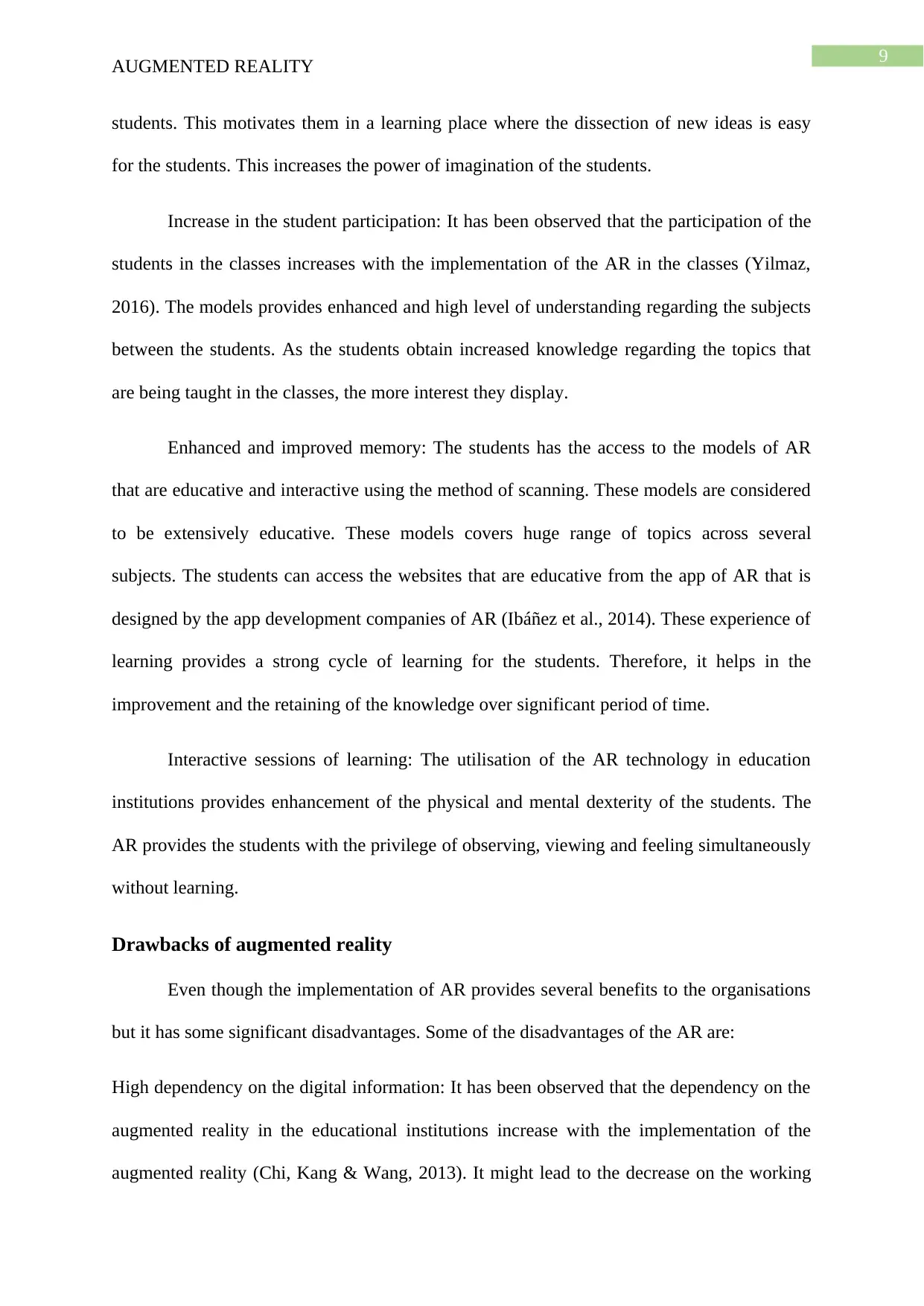
9
AUGMENTED REALITY
students. This motivates them in a learning place where the dissection of new ideas is easy
for the students. This increases the power of imagination of the students.
Increase in the student participation: It has been observed that the participation of the
students in the classes increases with the implementation of the AR in the classes (Yilmaz,
2016). The models provides enhanced and high level of understanding regarding the subjects
between the students. As the students obtain increased knowledge regarding the topics that
are being taught in the classes, the more interest they display.
Enhanced and improved memory: The students has the access to the models of AR
that are educative and interactive using the method of scanning. These models are considered
to be extensively educative. These models covers huge range of topics across several
subjects. The students can access the websites that are educative from the app of AR that is
designed by the app development companies of AR (Ibáñez et al., 2014). These experience of
learning provides a strong cycle of learning for the students. Therefore, it helps in the
improvement and the retaining of the knowledge over significant period of time.
Interactive sessions of learning: The utilisation of the AR technology in education
institutions provides enhancement of the physical and mental dexterity of the students. The
AR provides the students with the privilege of observing, viewing and feeling simultaneously
without learning.
Drawbacks of augmented reality
Even though the implementation of AR provides several benefits to the organisations
but it has some significant disadvantages. Some of the disadvantages of the AR are:
High dependency on the digital information: It has been observed that the dependency on the
augmented reality in the educational institutions increase with the implementation of the
augmented reality (Chi, Kang & Wang, 2013). It might lead to the decrease on the working
AUGMENTED REALITY
students. This motivates them in a learning place where the dissection of new ideas is easy
for the students. This increases the power of imagination of the students.
Increase in the student participation: It has been observed that the participation of the
students in the classes increases with the implementation of the AR in the classes (Yilmaz,
2016). The models provides enhanced and high level of understanding regarding the subjects
between the students. As the students obtain increased knowledge regarding the topics that
are being taught in the classes, the more interest they display.
Enhanced and improved memory: The students has the access to the models of AR
that are educative and interactive using the method of scanning. These models are considered
to be extensively educative. These models covers huge range of topics across several
subjects. The students can access the websites that are educative from the app of AR that is
designed by the app development companies of AR (Ibáñez et al., 2014). These experience of
learning provides a strong cycle of learning for the students. Therefore, it helps in the
improvement and the retaining of the knowledge over significant period of time.
Interactive sessions of learning: The utilisation of the AR technology in education
institutions provides enhancement of the physical and mental dexterity of the students. The
AR provides the students with the privilege of observing, viewing and feeling simultaneously
without learning.
Drawbacks of augmented reality
Even though the implementation of AR provides several benefits to the organisations
but it has some significant disadvantages. Some of the disadvantages of the AR are:
High dependency on the digital information: It has been observed that the dependency on the
augmented reality in the educational institutions increase with the implementation of the
augmented reality (Chi, Kang & Wang, 2013). It might lead to the decrease on the working
Secure Best Marks with AI Grader
Need help grading? Try our AI Grader for instant feedback on your assignments.
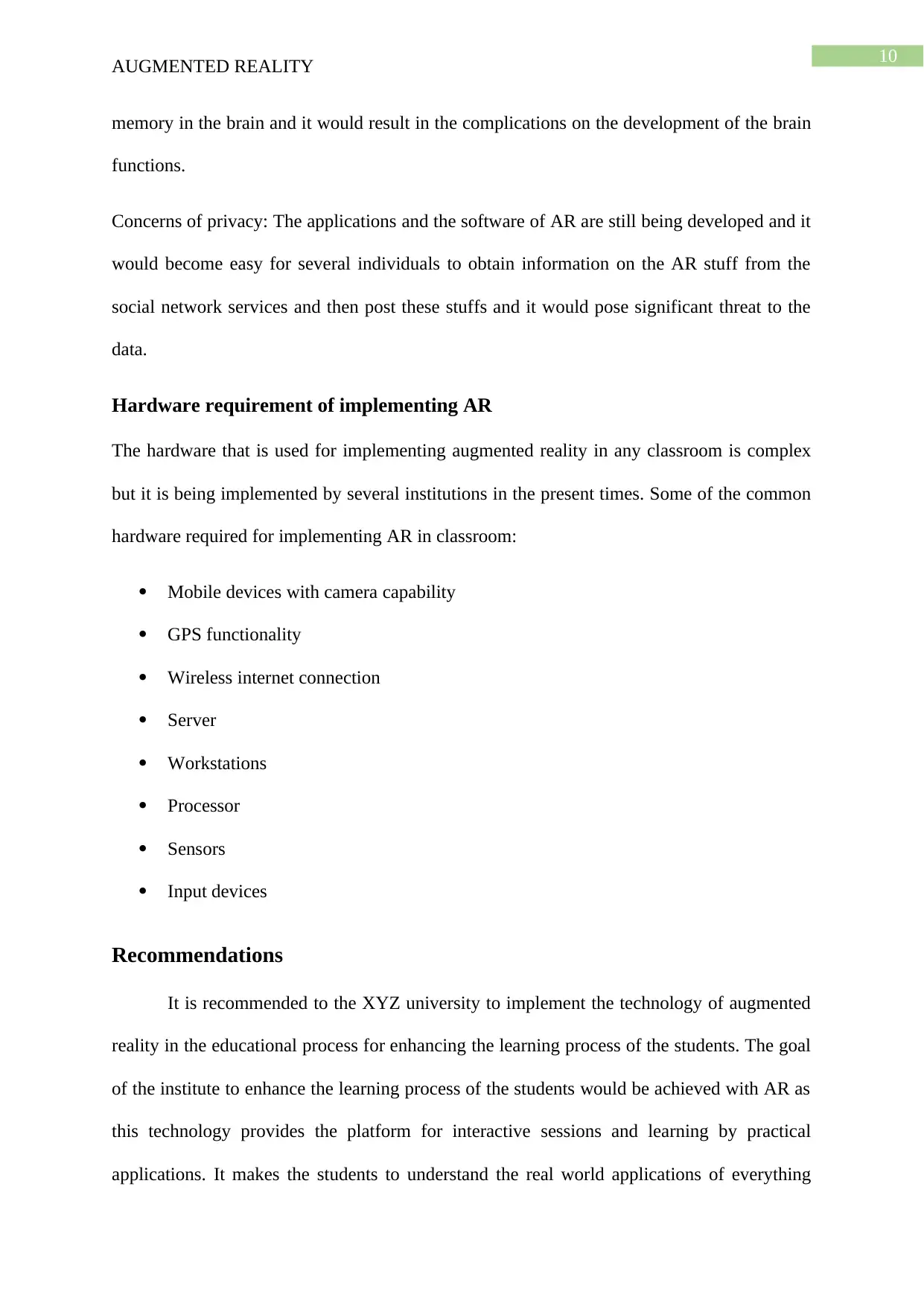
10
AUGMENTED REALITY
memory in the brain and it would result in the complications on the development of the brain
functions.
Concerns of privacy: The applications and the software of AR are still being developed and it
would become easy for several individuals to obtain information on the AR stuff from the
social network services and then post these stuffs and it would pose significant threat to the
data.
Hardware requirement of implementing AR
The hardware that is used for implementing augmented reality in any classroom is complex
but it is being implemented by several institutions in the present times. Some of the common
hardware required for implementing AR in classroom:
Mobile devices with camera capability
GPS functionality
Wireless internet connection
Server
Workstations
Processor
Sensors
Input devices
Recommendations
It is recommended to the XYZ university to implement the technology of augmented
reality in the educational process for enhancing the learning process of the students. The goal
of the institute to enhance the learning process of the students would be achieved with AR as
this technology provides the platform for interactive sessions and learning by practical
applications. It makes the students to understand the real world applications of everything
AUGMENTED REALITY
memory in the brain and it would result in the complications on the development of the brain
functions.
Concerns of privacy: The applications and the software of AR are still being developed and it
would become easy for several individuals to obtain information on the AR stuff from the
social network services and then post these stuffs and it would pose significant threat to the
data.
Hardware requirement of implementing AR
The hardware that is used for implementing augmented reality in any classroom is complex
but it is being implemented by several institutions in the present times. Some of the common
hardware required for implementing AR in classroom:
Mobile devices with camera capability
GPS functionality
Wireless internet connection
Server
Workstations
Processor
Sensors
Input devices
Recommendations
It is recommended to the XYZ university to implement the technology of augmented
reality in the educational process for enhancing the learning process of the students. The goal
of the institute to enhance the learning process of the students would be achieved with AR as
this technology provides the platform for interactive sessions and learning by practical
applications. It makes the students to understand the real world applications of everything
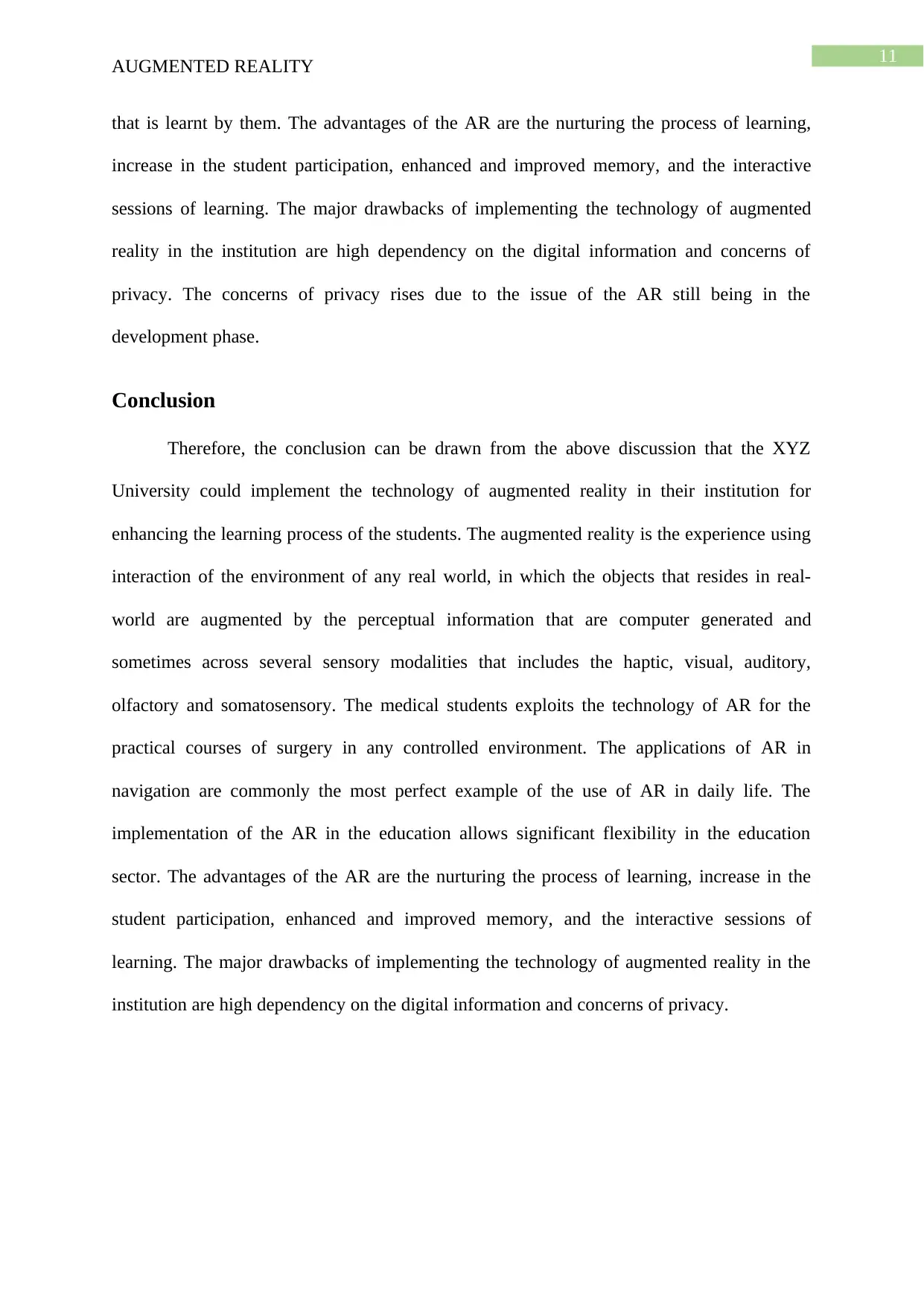
11
AUGMENTED REALITY
that is learnt by them. The advantages of the AR are the nurturing the process of learning,
increase in the student participation, enhanced and improved memory, and the interactive
sessions of learning. The major drawbacks of implementing the technology of augmented
reality in the institution are high dependency on the digital information and concerns of
privacy. The concerns of privacy rises due to the issue of the AR still being in the
development phase.
Conclusion
Therefore, the conclusion can be drawn from the above discussion that the XYZ
University could implement the technology of augmented reality in their institution for
enhancing the learning process of the students. The augmented reality is the experience using
interaction of the environment of any real world, in which the objects that resides in real-
world are augmented by the perceptual information that are computer generated and
sometimes across several sensory modalities that includes the haptic, visual, auditory,
olfactory and somatosensory. The medical students exploits the technology of AR for the
practical courses of surgery in any controlled environment. The applications of AR in
navigation are commonly the most perfect example of the use of AR in daily life. The
implementation of the AR in the education allows significant flexibility in the education
sector. The advantages of the AR are the nurturing the process of learning, increase in the
student participation, enhanced and improved memory, and the interactive sessions of
learning. The major drawbacks of implementing the technology of augmented reality in the
institution are high dependency on the digital information and concerns of privacy.
AUGMENTED REALITY
that is learnt by them. The advantages of the AR are the nurturing the process of learning,
increase in the student participation, enhanced and improved memory, and the interactive
sessions of learning. The major drawbacks of implementing the technology of augmented
reality in the institution are high dependency on the digital information and concerns of
privacy. The concerns of privacy rises due to the issue of the AR still being in the
development phase.
Conclusion
Therefore, the conclusion can be drawn from the above discussion that the XYZ
University could implement the technology of augmented reality in their institution for
enhancing the learning process of the students. The augmented reality is the experience using
interaction of the environment of any real world, in which the objects that resides in real-
world are augmented by the perceptual information that are computer generated and
sometimes across several sensory modalities that includes the haptic, visual, auditory,
olfactory and somatosensory. The medical students exploits the technology of AR for the
practical courses of surgery in any controlled environment. The applications of AR in
navigation are commonly the most perfect example of the use of AR in daily life. The
implementation of the AR in the education allows significant flexibility in the education
sector. The advantages of the AR are the nurturing the process of learning, increase in the
student participation, enhanced and improved memory, and the interactive sessions of
learning. The major drawbacks of implementing the technology of augmented reality in the
institution are high dependency on the digital information and concerns of privacy.
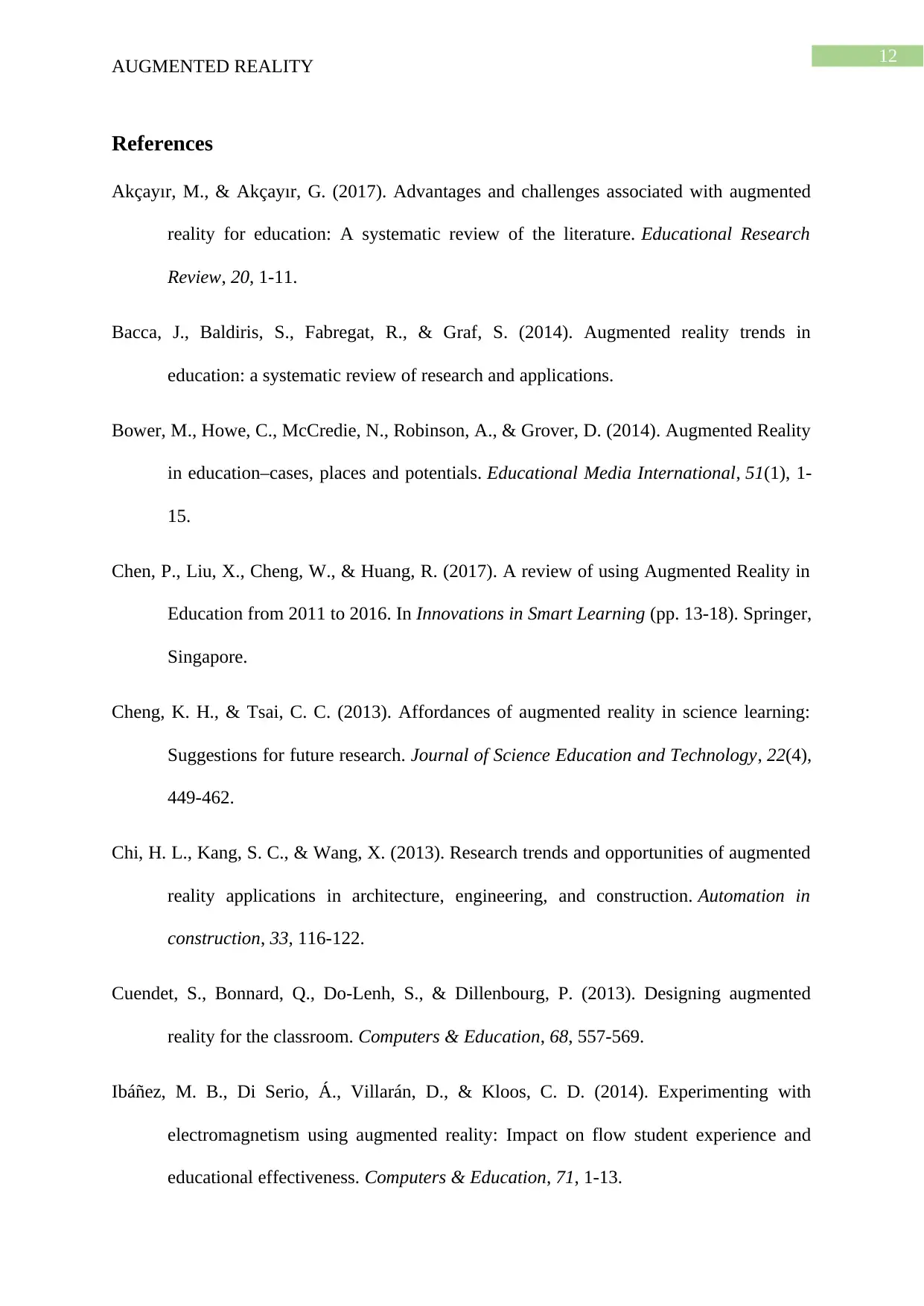
12
AUGMENTED REALITY
References
Akçayır, M., & Akçayır, G. (2017). Advantages and challenges associated with augmented
reality for education: A systematic review of the literature. Educational Research
Review, 20, 1-11.
Bacca, J., Baldiris, S., Fabregat, R., & Graf, S. (2014). Augmented reality trends in
education: a systematic review of research and applications.
Bower, M., Howe, C., McCredie, N., Robinson, A., & Grover, D. (2014). Augmented Reality
in education–cases, places and potentials. Educational Media International, 51(1), 1-
15.
Chen, P., Liu, X., Cheng, W., & Huang, R. (2017). A review of using Augmented Reality in
Education from 2011 to 2016. In Innovations in Smart Learning (pp. 13-18). Springer,
Singapore.
Cheng, K. H., & Tsai, C. C. (2013). Affordances of augmented reality in science learning:
Suggestions for future research. Journal of Science Education and Technology, 22(4),
449-462.
Chi, H. L., Kang, S. C., & Wang, X. (2013). Research trends and opportunities of augmented
reality applications in architecture, engineering, and construction. Automation in
construction, 33, 116-122.
Cuendet, S., Bonnard, Q., Do-Lenh, S., & Dillenbourg, P. (2013). Designing augmented
reality for the classroom. Computers & Education, 68, 557-569.
Ibáñez, M. B., Di Serio, Á., Villarán, D., & Kloos, C. D. (2014). Experimenting with
electromagnetism using augmented reality: Impact on flow student experience and
educational effectiveness. Computers & Education, 71, 1-13.
AUGMENTED REALITY
References
Akçayır, M., & Akçayır, G. (2017). Advantages and challenges associated with augmented
reality for education: A systematic review of the literature. Educational Research
Review, 20, 1-11.
Bacca, J., Baldiris, S., Fabregat, R., & Graf, S. (2014). Augmented reality trends in
education: a systematic review of research and applications.
Bower, M., Howe, C., McCredie, N., Robinson, A., & Grover, D. (2014). Augmented Reality
in education–cases, places and potentials. Educational Media International, 51(1), 1-
15.
Chen, P., Liu, X., Cheng, W., & Huang, R. (2017). A review of using Augmented Reality in
Education from 2011 to 2016. In Innovations in Smart Learning (pp. 13-18). Springer,
Singapore.
Cheng, K. H., & Tsai, C. C. (2013). Affordances of augmented reality in science learning:
Suggestions for future research. Journal of Science Education and Technology, 22(4),
449-462.
Chi, H. L., Kang, S. C., & Wang, X. (2013). Research trends and opportunities of augmented
reality applications in architecture, engineering, and construction. Automation in
construction, 33, 116-122.
Cuendet, S., Bonnard, Q., Do-Lenh, S., & Dillenbourg, P. (2013). Designing augmented
reality for the classroom. Computers & Education, 68, 557-569.
Ibáñez, M. B., Di Serio, Á., Villarán, D., & Kloos, C. D. (2014). Experimenting with
electromagnetism using augmented reality: Impact on flow student experience and
educational effectiveness. Computers & Education, 71, 1-13.
Paraphrase This Document
Need a fresh take? Get an instant paraphrase of this document with our AI Paraphraser
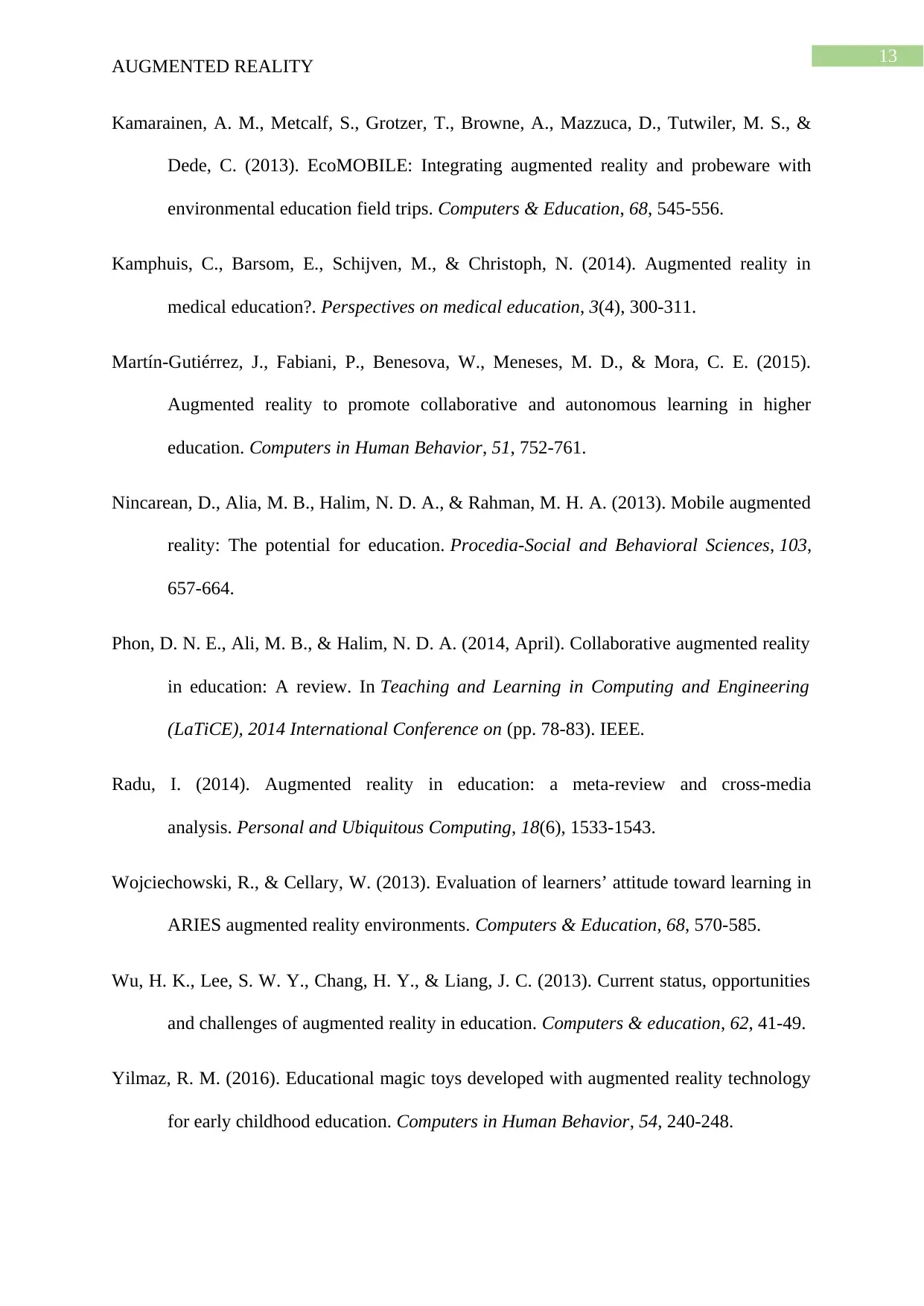
13
AUGMENTED REALITY
Kamarainen, A. M., Metcalf, S., Grotzer, T., Browne, A., Mazzuca, D., Tutwiler, M. S., &
Dede, C. (2013). EcoMOBILE: Integrating augmented reality and probeware with
environmental education field trips. Computers & Education, 68, 545-556.
Kamphuis, C., Barsom, E., Schijven, M., & Christoph, N. (2014). Augmented reality in
medical education?. Perspectives on medical education, 3(4), 300-311.
Martín-Gutiérrez, J., Fabiani, P., Benesova, W., Meneses, M. D., & Mora, C. E. (2015).
Augmented reality to promote collaborative and autonomous learning in higher
education. Computers in Human Behavior, 51, 752-761.
Nincarean, D., Alia, M. B., Halim, N. D. A., & Rahman, M. H. A. (2013). Mobile augmented
reality: The potential for education. Procedia-Social and Behavioral Sciences, 103,
657-664.
Phon, D. N. E., Ali, M. B., & Halim, N. D. A. (2014, April). Collaborative augmented reality
in education: A review. In Teaching and Learning in Computing and Engineering
(LaTiCE), 2014 International Conference on (pp. 78-83). IEEE.
Radu, I. (2014). Augmented reality in education: a meta-review and cross-media
analysis. Personal and Ubiquitous Computing, 18(6), 1533-1543.
Wojciechowski, R., & Cellary, W. (2013). Evaluation of learners’ attitude toward learning in
ARIES augmented reality environments. Computers & Education, 68, 570-585.
Wu, H. K., Lee, S. W. Y., Chang, H. Y., & Liang, J. C. (2013). Current status, opportunities
and challenges of augmented reality in education. Computers & education, 62, 41-49.
Yilmaz, R. M. (2016). Educational magic toys developed with augmented reality technology
for early childhood education. Computers in Human Behavior, 54, 240-248.
AUGMENTED REALITY
Kamarainen, A. M., Metcalf, S., Grotzer, T., Browne, A., Mazzuca, D., Tutwiler, M. S., &
Dede, C. (2013). EcoMOBILE: Integrating augmented reality and probeware with
environmental education field trips. Computers & Education, 68, 545-556.
Kamphuis, C., Barsom, E., Schijven, M., & Christoph, N. (2014). Augmented reality in
medical education?. Perspectives on medical education, 3(4), 300-311.
Martín-Gutiérrez, J., Fabiani, P., Benesova, W., Meneses, M. D., & Mora, C. E. (2015).
Augmented reality to promote collaborative and autonomous learning in higher
education. Computers in Human Behavior, 51, 752-761.
Nincarean, D., Alia, M. B., Halim, N. D. A., & Rahman, M. H. A. (2013). Mobile augmented
reality: The potential for education. Procedia-Social and Behavioral Sciences, 103,
657-664.
Phon, D. N. E., Ali, M. B., & Halim, N. D. A. (2014, April). Collaborative augmented reality
in education: A review. In Teaching and Learning in Computing and Engineering
(LaTiCE), 2014 International Conference on (pp. 78-83). IEEE.
Radu, I. (2014). Augmented reality in education: a meta-review and cross-media
analysis. Personal and Ubiquitous Computing, 18(6), 1533-1543.
Wojciechowski, R., & Cellary, W. (2013). Evaluation of learners’ attitude toward learning in
ARIES augmented reality environments. Computers & Education, 68, 570-585.
Wu, H. K., Lee, S. W. Y., Chang, H. Y., & Liang, J. C. (2013). Current status, opportunities
and challenges of augmented reality in education. Computers & education, 62, 41-49.
Yilmaz, R. M. (2016). Educational magic toys developed with augmented reality technology
for early childhood education. Computers in Human Behavior, 54, 240-248.

14
AUGMENTED REALITY
Zhu, E., Hadadgar, A., Masiello, I., & Zary, N. (2014). Augmented reality in healthcare
education: an integrative review. PeerJ, 2, e469.
AUGMENTED REALITY
Zhu, E., Hadadgar, A., Masiello, I., & Zary, N. (2014). Augmented reality in healthcare
education: an integrative review. PeerJ, 2, e469.

15
AUGMENTED REALITY
AUGMENTED REALITY
Secure Best Marks with AI Grader
Need help grading? Try our AI Grader for instant feedback on your assignments.

16
AUGMENTED REALITY
AUGMENTED REALITY

17
AUGMENTED REALITY
AUGMENTED REALITY

18
AUGMENTED REALITY
AUGMENTED REALITY
1 out of 19
Related Documents
Your All-in-One AI-Powered Toolkit for Academic Success.
+13062052269
info@desklib.com
Available 24*7 on WhatsApp / Email
![[object Object]](/_next/static/media/star-bottom.7253800d.svg)
Unlock your academic potential
© 2024 | Zucol Services PVT LTD | All rights reserved.





